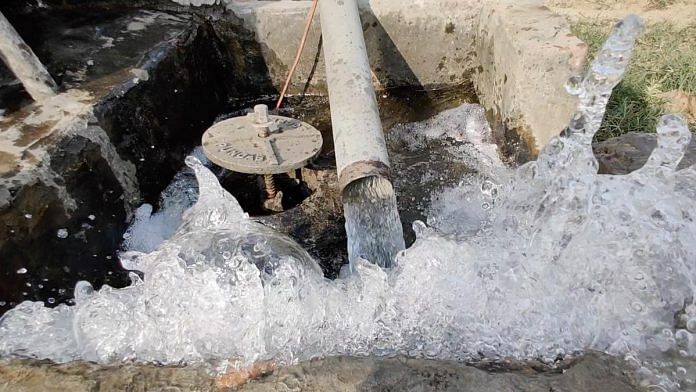Leonardo da Vinci once said, “Water is the driving force of all nature.” India has four per cent of the world’s water resources, but in 2011, it moved to be water-stressed. A 2019 NITI Aayog report said that India is suffering from the worst water crisis in its history, and almost 600 million of its population is water-deprived. The report goes on to add that 21 cities — including Bangalore, Delhi, Hyderabad and Chennai — probably exhausted their groundwater resources in 2021.
Agriculture is the main consumer of water stock in India. In rural India, 80 to 90 per cent of drinking water needs are fulfilled by groundwater resources. What is worrisome is that groundwater levels in India declined by over 60 per cent between 2007 and 2017, and of the extracted water, almost 90 per cent is used in agriculture. In a 2014 report, the Bharatiya Agro Industries Foundation estimated that 70 per cent of India’s farming is rain-fed. Yet, 65 per cent of its total rainfall ends up in the sea. Water pollution is another source of water stress, leading to collateral losses in healthcare. Cities are home to 36 per cent of India’s population but account for 70 per cent of water pollution, according to a report by the Central Pollution Control Board.
Water is resource, not commodity
In India, water resources are treated as commons. It is not treated as an economic resource that has monetary value and a price to pay for its consumption. We also consume rapaciously in the false belief that rain will replenish our water stock. On a per capita basis, water availability has been declining — from 1,816 cubic meters in 2001 and 1,546 in 2011 to 1,367 cubic meters in 2021.
In India, water is a source of huge inequality. Often, when a water source is impaired, the many people who had found employment through it get negatively impacted. Employment in fishing, sand mining, water-carrying services gets impacted. The restoration of the water supply often leads to the privileged cornering access to it. Large queues at water tankers outside slums is a common visual in our cities. Almost all our high-rise buildings supplement water by buying tankers.
India’s water problems are both huge and complex. By creating the Ministry of Jal Shakti in 2019, the Narendra Modi government attempted to consolidate all departments and ministries that dealt with water issues to focus exclusively on addressing India’s water challenges. However, at the micro level, the multiplicity of the departments that govern water and allied issues is still a huge hurdle to a composite view and sustainable solutions. In the last two Union Budgets, the emphasis has clearly been on economic development that is inclusive and sustainable at the same time.
In the 2021-22 Budget, Finance Minister Nirmala Sitharaman allocated Rs 2,87,000 crore to the Ministry of Jal Shakti to launch the Jal Jeevan Mission (Urban) to ensure universal water supply to all 4,378 towns. The government is also committed to providing safe tap drinking water to every rural household by 2024. While it is a laudable target in itself, what needs to be addressed is the reversal of the shrinking stock of potable water to supply these homes.
The government cannot manage the water crisis alone; it will take the combined efforts of civil society, the private sector – including its foundations – and the public at large to meet the challenge.
Also read: What the latest IPCC report on climate vulnerability & adaptation means for India
Some key changes
It is important to reimagine the assessment protocol for water as a resource and bring it on par with all other economic resources. Management requires a measure to work with, and water also needs to be treated as a life-form resource rather than just a human-centric one. We need to re-structure the Centre-state and local bodies’ relationship with water as a subject and allow for single-window decision making.
We need to address the issues of budgetary support for the maintenance of infrastructure and supplementing and building up source stocks. Huge investments in water harvesting are needed to build and protect water availability and to harvest a reasonable part of the monsoon flows. We also need a massive restoration drive to clean up our existing water bodies, be it village tanks or baolis.
Equally important is a national literacy mission around water to create multilevel hydro-literacy in schools and civil society. The media has a strong role to play in reiterating the message. Corporates need to educate their staff to create an all-pervasive ISR (individual social responsibility) structure. It is important to recognise the changing patterns of water availability due to climate change, especially modelling future scenarios to study the impact of receding glaciers that will cause our rivers to dry up and altered rainfall patterns affecting cropping patterns and impacting food security.
It would be fruitful to relook at ancient farming practices that seemed more sustainable. Many of the northeastern states are using traditional ways of irrigating and recycling the run-off water to use in fields before it rejoins the river. In Tamil Nadu, a centuries-old tradition called ‘Eri’ is used in irrigating paddy fields from lake water.
Last, but not least, we have a huge philosophical debate to address. And that is around agriculture. Can we create community ownership constructs, and can all of rural India be asked to pay for water that values the precious resource adequately? Second, in a country that is sustaining its agriculture by rain-fed systems, is it really viable to practice multi-crop agriculture based on groundwater extraction?
Paul Abraham is president at The Hinduja Foundation. Views are personal.
(Edited by Humra Laeeq)



